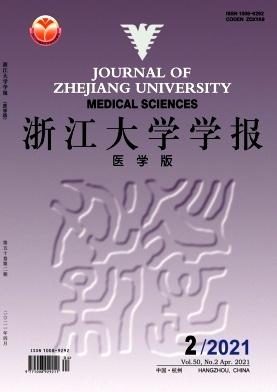Clinical characteristics and genetic analysis of six children with carnitine palmitoyltransferase 2 deficiency.
Q2 Medicine
Zhejiang da xue xue bao. Yi xue ban = Journal of Zhejiang University. Medical sciences
Pub Date : 2024-04-12
DOI:10.3724/zdxbyxb-2023-0611
引用次数: 0
Abstract
OBJECTIVES To investigate the clinical characteristic and genetic variants of children with carnitine palmitoyltransferase 2 (CPT2) deficiency. METHODS The clinical and genetic data of 6 children with CPT2 deficiency were retrospectively analyzed. The blood acylcarnitines and genetic variants were detected with tandem mass spectrometry and whole-exon gene sequencing, respectively. RESULTS There were 4 males and 2 females and the mean age at diagnosis was 32 months (15 d~9 y). One case was asymptomatic, 2 had delayed onset, and 3 were of infantile type. Three cases were diagnosed at neonatal screening, and 3 cases presented with clinical manifestations of fever, muscle weakness, and increased muscle enzymes. Five children presented with decreased free carnitine and elevated levels of palmitoyl and octadecenoyl carnitines. CPT2 gene variants were detected at 8 loci in 6 children (4 harboring biallelic mutations and 2 harboring single locus mutations), including 3 known variants (p.R631C, p.T589M, and p.D255G) and 5 newly reported variants (p.F352L, p.R498L, p.F434S, p.A515P, and c.153-2A>G). It was predicted by PolyPhen2 and SIFT software that c.153-2A>G and p.F352L were suspected pathogenic variants, and p.R498L, p.F434S and p.A515P were variants of unknown clinical significance. CONCLUSIONS The clinical phenotypes of CPT2 deficiency are diverse. The early diagnosis can be facilitated by neonatal blood tandem mass spectrometry screening and genetic testing, and most of them have good prognosis after timely diagnosis and treatment.六名肉碱棕榈酰转移酶 2 缺乏症患儿的临床特征和基因分析。
目的研究肉碱棕榈酰基转移酶2(CPT2)缺乏症患儿的临床特征和遗传变异。方法回顾性分析了6名CPT2缺乏症患儿的临床和遗传数据。结果:患儿中 4 男 2 女,诊断时平均年龄为 32 个月(15 d~9 y)。其中 1 例无症状,2 例延迟发病,3 例为婴儿型。3例在新生儿筛查时确诊,3例有发热、肌无力和肌酶增高的临床表现。5名儿童表现为游离肉碱减少,棕榈酰肉碱和十八碳烯酰基肉碱水平升高。在6名儿童的8个基因位点上检测到了CPT2基因变异(4人携带双倍突变,2人携带单位点突变),包括3个已知变异(p.R631C、p.T589M和p.D255G)和5个新报道的变异(p.F352L、p.R498L、p.F434S、p.A515P和c.153-2A>G)。通过 PolyPhen2 和 SIFT 软件预测,c.153-2A>G 和 p.F352L 为疑似致病变异,p.R498L、p.F434S 和 p.A515P 为临床意义不明的变异。结论:CPT2 缺乏症的临床表型多种多样,新生儿血液串联质谱筛查和基因检测有助于早期诊断,及时诊断和治疗后多数预后良好。
本文章由计算机程序翻译,如有差异,请以英文原文为准。
求助全文
约1分钟内获得全文
求助全文
来源期刊

Zhejiang da xue xue bao. Yi xue ban = Journal of Zhejiang University. Medical sciences
Medicine-Medicine (all)
CiteScore
3.80
自引率
0.00%
发文量
67
 求助内容:
求助内容: 应助结果提醒方式:
应助结果提醒方式:


